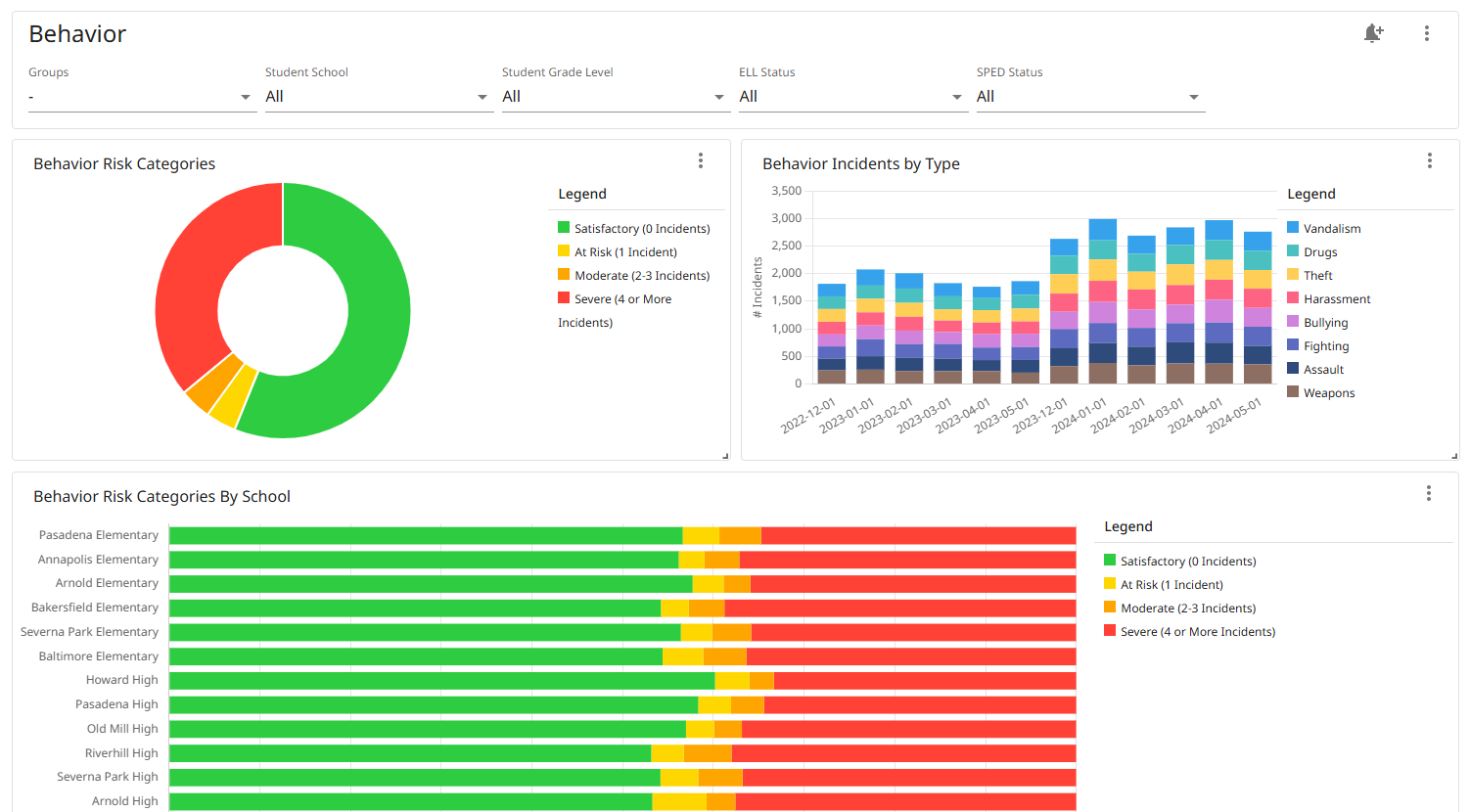
Behavioral data in schools is more than just a record of incidents—it’s a goldmine of insights that can help educators foster safer, more inclusive environments. By analyzing major and minor behavior incidents, schools and districts can uncover trends, identify areas for improvement, and address inequities, ensuring all students receive the support they need.
Schoolytics makes this process seamless, helping districts organize and analyze behavioral data, even the often-overlooked "minor behavior" incidents typically buried in spreadsheets. In this post, we explore how schools can use data to analyze behavior, address disproportionality, compare trends, allocate resources, and support students at risk.
Understanding and Addressing Disproportionality
One of the most critical aspects of behavior data analysis is identifying disproportionality. Disproportionality occurs when certain student groups—based on race/ethnicity, special education status, or other factors—experience behavior incidents, interventions, or consequences at rates significantly higher than their peers.

Key Steps for Disproportionality Analysis:
- Segment by Student Demographics: Break down behavioral data by race/ethnicity, special education status, English learner status, socioeconomic background, and other relevant factors.
- Calculate Rates: Analyze the percentage of incidents for each group relative to their proportion in the student population. For example, if Black students make up 10% of a school’s enrollment but 30% of suspensions, this highlights an equity concern.
- Identify Trends Over Time: Use year-over-year data to see if interventions are helping reduce disparities or if the trends are persistent.
Taking Action: When inequities are identified, schools can implement culturally responsive practices, review discipline policies, and train staff on implicit bias and restorative approaches. Tracking progress over time is essential to measure the impact of these changes.
Spotting Year-Over-Year Trends
Behavior data isn’t static—it’s dynamic and evolves with policies, interventions, and external factors. Comparing data year-over-year allows schools to assess the effectiveness of their strategies.
Example Trends to Watch:
- Decrease in Minor Incidents: Are proactive measures, like social-emotional learning programs, reducing minor behavior incidents over time?
- Reduction in Major Incidents: Are restorative justice practices leading to fewer suspensions or expulsions?
- Emerging Patterns by Grade Level: Are specific grade levels consistently experiencing higher incidents? Are new challenges appearing in certain cohorts?
Taking Action: By using tools like Schoolytics, districts can easily visualize trends, identify successes, and spot areas needing attention.
Comparing Across School Sites and Grade Levels
Behavior patterns can vary significantly across school sites and grade levels. Analyzing data at these granular levels helps uncover localized needs and ensures equitable resource allocation.

Example Insights:
- School Site Comparisons: One elementary school may have a higher rate of playground incidents, while another has more classroom-related behaviors. This could signal a need for additional recess staff at one site and classroom management training at another.
- Grade Level Trends: Younger students, such as PreK through kindergarten, may have higher incidents of impulsive behaviors, while older students might face challenges with defiance or peer conflicts. Tailoring interventions to these developmental stages is critical.
Taking Action: With centralized reporting, districts can compare behavior data across sites and grades, ensuring that every school receives targeted support based on its unique needs.
Using Location Data to Allocate Resources Effectively
The location of behavior incidents often provides clues about where additional resources or interventions are needed. By drilling into location-specific data, schools can optimize their staffing and support strategies.

Example Scenarios:
- Playground Challenges for Younger Students: If data shows that the majority of PreK/TK/kindergarten incidents occur on the playground, schools can allocate more monitors to these areas during recess or implement structured play activities.
- Classroom Issues for Older Students: If older grades have a higher rate of classroom incidents, providing teachers with additional classroom management training or coaching could make a significant difference.
- Hotspots in Common Areas: Persistent issues in hallways, cafeterias, or other shared spaces may indicate a need for clearer expectations, supervision, or environmental design changes.

Taking Action: By analyzing where incidents occur, districts can proactively address problem areas and create safer environments for all students.
Identifying Students at Risk
Minor behavior incidents often serve as early warning signs for larger issues. By tracking patterns in minor infractions, schools can intervene early to support students before problems escalate.
What to Look For:
- Frequency: Are certain students repeatedly involved in minor incidents?
- Types of Incidents: Are the behaviors escalating in severity or transitioning into new categories (e.g., from talking out of turn to defiance)?
- Triggers: Are specific times, locations, or contexts consistently linked to the behaviors?
Taking Action: Here are some concrete steps to take once districts have the right data.
- Early Interventions: Develop targeted support plans, such as small-group counseling, mentoring, or family engagement, for students showing early signs of difficulty.
- Collaboration: Share insights with teachers, counselors, and families to create a unified support strategy.
- Track Progress: Monitor whether interventions are reducing the frequency or severity of incidents for at-risk students.
From Spreadsheets to Actionable Insights
Many districts already track behavior data, but much of it—especially minor incidents—remains in spreadsheets or siloed systems, making it difficult to analyze comprehensively. Schoolytics simplifies this process by consolidating and visualizing data, enabling schools to focus on taking action.

Flexible Forms: Schoolytics "Logs" allows districts to centralize their data collection, and replace spreadsheets and Google Forms with streamlined data.

Why Schoolytics for Behavior Data?
- Centralized Reporting: Access all behavior data in one place, including major and minor incidents.
- Customizable Dashboards: Tailor reports to highlight the metrics that matter most to your district.
- Drill-Down Capabilities: Analyze data by student, grade, school, incident type, and location with ease.
- Equity Insights: Identify disproportionality and track the effectiveness of interventions over time.
- Data Crosswalks: Layer on SEL and academic data to understand the causes and consequences of behavior incidents.
By transforming scattered data into meaningful insights, Schoolytics empowers educators to make informed decisions that improve outcomes for students.
Conclusion
Analyzing behavior data is a powerful way to create safer, more supportive school environments. Moreover, tracking minor behavior incidents helps identify students at risk, ensuring they receive the support they need before challenges escalate. With Schoolytics, schools can move beyond manual spreadsheets and harness the full potential of their data, making equity and student success a reality.
Behavioral data is more than numbers—it’s a tool for transformation. Let’s use it to build schools where every student thrives. 🚀
Related Articles


How to Pay for MTSS & Analytics Software: Harnessing Federal Funds
School districts are facing budgetary constraints that make it difficult to pay for new, innovative...

Transforming Student Support: Leveraging Schoolytics for Effective MTSS Implementation
In the quest to provide comprehensive support to students, academic leaders face the challenge of...

